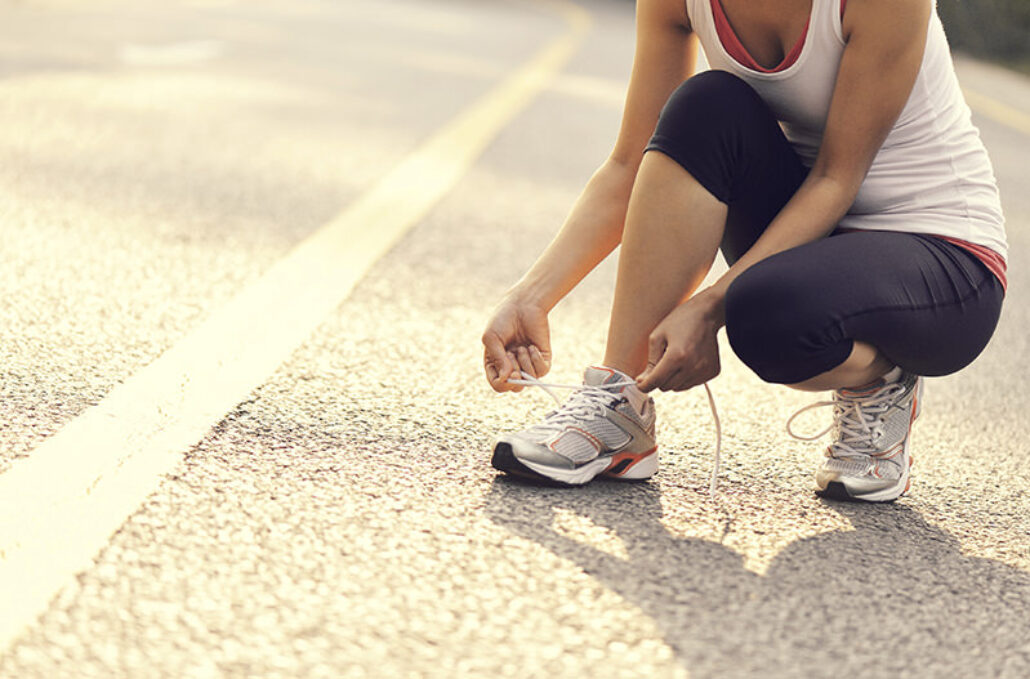Traditionally, running shoes are prescribed based on the shape of a runner’s arch. Recent studies have questioned the effectiveness of this approach. Physical therapist Sam Olson explains what we are learning about running shoes and injury prevention.
We love to run to stay fit. For recreational weekend warriors, dedicated marathoners, or the runners who fall somewhere in between, this cardio-healthy sport is one of the most popular in the country. As beneficial as running is, the incidence of yearly runner injury rates also has to be acknowledged. Running can put stress on tissues in the foot, shin, knee, and hips. Studies indicate that for every 1000 hours of running, a runner will experience between 2.5 and 12 injuries. Most of these are lower extremity overuse injuries caused by constant repetition of the same movement.
Research has been exploring the potential to reduce these injuries through choice of running shoe. Data indicates that running shoes can influence the amount of tissue stress runners experience as they run—but recent studies are calling into question the current practice of prescribing shoes based on foot arch type.
“Traditionally,” explains Summit physical therapist Sam Olson, “runners have been prescribed shoes based on the shape of their arch. Runners with flat feet were given shoes designed to control motion. If you had a neutral foot, you got a stability shoe, and runners with high arches are given cushioned shoes. However, a series of studies found no statistical difference in injury rates between runners in shoes selected for their arch shape and runners who wore stability shoes regardless of arch shape. There is growing consensus that shoes selected based on arch shape won’t provide better protection from running-related injuries.”
“There’s no single shoe type that is superior to all other running shoes,” Sam says. “Different runners respond differently to footwear types, and shoe characteristics that are helpful for one person may not be helpful for another person. Multiple experts say comfort should be the most important factor in selecting an athletic shoe.”
At Summit, runners are evaluated based on how they move and control their body. Running form, as well as individual injury history, are used to help patients make the right shoe choice.
“Injury history can help us decide which shoe is best for a patient,” Sam explains. “Although the American College of Sports Medicine now advocates more of a minimalist shoe, foot and calf injuries should not be transitioned into a minimalist shoe right away. First we’d want to treat the injured area through exercise and manual therapy. We might consider the transition after symptoms subside. On the other hand, patients with a knee or hip injury may benefit from a minimal shoe.”
Sam is quick to point out, however, that correct running form is more important than shoes. “We help our patients work on form; on the mechanics of running,” says Sam. “Injury risks can be reduced by activating certain muscles, improving cadence and focusing on where the foot is landing in relation to your body.”
At Summit, we constantly monitor sports medicine research to offer the safest and most effective running resources to help our patients reach their objectives for a healthy, active lifestyle.
Summit Orthopedics offers personalized foot and ankle expertise
Our fellowship-trained foot and ankle physicians understand that your mobility depends on the health of your feet and ankles. If you have suffered an injury or are experiencing symptoms that make walking painful, our team of foot and ankle specialists can help with conservative treatment, seasoned surgical teams, and expert rehabilitation support. Summit Orthopedics specialists have the expertise to evaluate your discomfort and develop a plan to quickly and safely get you back on your feet and on your way.
Start your journey to optimal foot health. Find your foot and ankle expert, request an appointment online, or call us at (651) 968–5201 to schedule a consultation.
Summit has convenient locations across the Minneapolis-St. Paul metro area, serving Minnesota and western Wisconsin. We have state-of-the-art centers for comprehensive orthopedic care in Eagan, MN, Plymouth, MN, Vadnais Heights, MN, and Woodbury, MN, as well as additional community clinics throughout the metro and southern Minnesota.
More resources for you
- Are Your Shoes Dangerous To Your Foot Health?
- Ask Sam Olson: How Do I Find The Right Running Shoe?
- Ask Sam Olson: Does My Running Shoe Matter?

